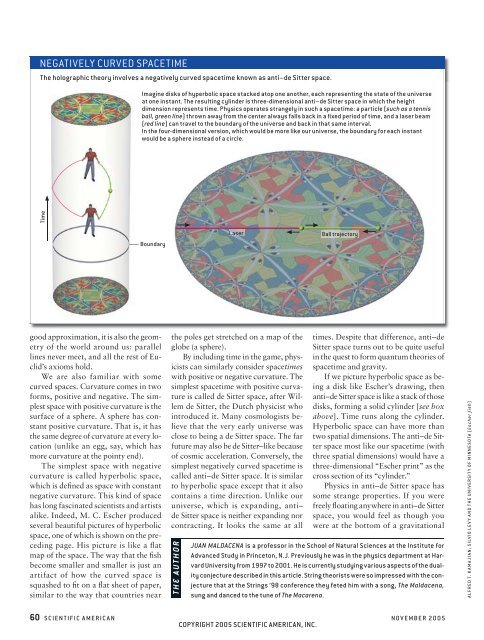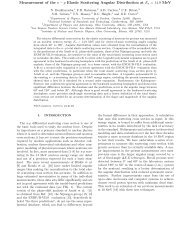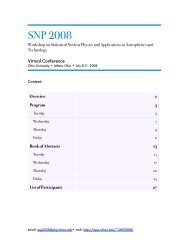The Illusion of Gravity
The Illusion of Gravity
The Illusion of Gravity
Create successful ePaper yourself
Turn your PDF publications into a flip-book with our unique Google optimized e-Paper software.
NEGATIVELY CURVED SPACETIME<strong>The</strong> holographic theory involves a negatively curved spacetime known as anti–de Sitter space.subtitlelabelImagine disks <strong>of</strong> hyperbolic space stacked atop one another, each representing the state <strong>of</strong> the universeat one instant. <strong>The</strong> resulting cylinder is three-dimensional anti–de Sitter space in which the heightdimension represents time. Physics operates strangely in such a spacetime: a particle (such as a tennisball, green line) thrown away from the center always falls back in a fixed period <strong>of</strong> time, and a laser beam(red line) can travel to the boundary <strong>of</strong> the universe and back in that same interval.In the four-dimensional version, which would be more like our universe, the boundary for each instantwould be a sphere instead <strong>of</strong> a circle.TimeBoundaryLaserBall trajectorygood approximation, it is also the geometry<strong>of</strong> the world around us: parallellines never meet, and all the rest <strong>of</strong> Euclid’saxioms hold.We are also familiar with somecurved spaces. Curvature comes in tw<strong>of</strong>orms, positive and negative. <strong>The</strong> simplestspace with positive curvature is thesurface <strong>of</strong> a sphere. A sphere has constantpositive curvature. That is, it hasthe same degree <strong>of</strong> curvature at every location(unlike an egg, say, which hasmore curvature at the pointy end).<strong>The</strong> simplest space with negativecurvature is called hyperbolic space,which is defined as space with constantnegative curvature. This kind <strong>of</strong> spacehas long fascinated scientists and artistsalike. Indeed, M. C. Escher producedseveral beautiful pictures <strong>of</strong> hyperbolicspace, one <strong>of</strong> which is shown on the precedingpage. His picture is like a fl atmap <strong>of</strong> the space. <strong>The</strong> way that the fishbecome smaller and smaller is just anartifact <strong>of</strong> how the curved space issquashed to fit on a flat sheet <strong>of</strong> paper,similar to the way that countries nearthe poles get stretched on a map <strong>of</strong> theglobe (a sphere).By including time in the game, physicistscan similarly consider spacetimeswith positive or negative curvature. <strong>The</strong>simplest spacetime with positive curvatureis called de Sitter space, after Willemde Sitter, the Dutch physicist whointroduced it. Many cosmologists believethat the very early universe wasclose to being a de Sitter space. <strong>The</strong> farfuture may also be de Sitter–like because<strong>of</strong> cosmic acceleration. Conversely, thesimplest negatively curved space time iscalled anti–de Sitter space. It is similarto hyperbolic space except that it alsocontains a time direction. Unlike ouruniverse, which is expanding, anti–de Sitter space is neither expanding norcontracting. It looks the same at allTHE AUTHORtimes. Despite that difference, anti–deSitter space turns out to be quite usefulin the quest to form quantum theories <strong>of</strong>spacetime and gravity.If we picture hyperbolic space as beinga disk like Escher’s drawing, thenanti–de Sitter space is like a stack <strong>of</strong> thosedisks, forming a solid cylinder [see boxabove]. Time runs along the cylinder.Hyperbolic space can have more thantwo spatial dimensions. <strong>The</strong> anti–de Sitterspace most like our space time (withthree spatial dimensions) would have athree-dimensional “Escher print” as thecross section <strong>of</strong> its “cylinder.”Physics in anti–de Sitter space hassome strange properties. If you werefreely floating anywhere in anti–de Sitterspace, you would feel as though youwere at the bottom <strong>of</strong> a gravitationalJUAN MALDACENA is a pr<strong>of</strong>essor in the School <strong>of</strong> Natural Sciences at the Institute forAdvanced Study in Princeton, N.J. Previously he was in the physics department at HarvardUniversity from 1997 to 2001. He is currently studying various aspects <strong>of</strong> the dualityconjecture described in this article. String theorists were so impressed with the conjecturethat at the Strings ’98 conference they feted him with a song, <strong>The</strong> Maldacena,sung and danced to the tune <strong>of</strong> <strong>The</strong> Macarena.ALFRED T. K AMA JIAN; SILVIO LEV Y AND THE UNIVERSIT Y OF MINNESOTA (Escher fish)60 SCIENTIFIC AMERICAN NOVEMBER 2005COPYRIGHT 2005 SCIENTIFIC AMERICAN, INC.








